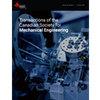两点接触高运动副约束下空间冗余驱动并联机构逆动力学的比较研究
IF 1
4区 工程技术
Q4 ENGINEERING, MECHANICAL
Transactions of The Canadian Society for Mechanical Engineering
Pub Date : 2022-12-22
DOI:10.1139/tcsme-2022-0119
引用次数: 0
摘要
受人类咀嚼的启发,设计了一种受两点接触高级运动副约束的真人大小空间冗余驱动并联机构。为了便于其在实际中的实时控制,本文建立了一个精确的逆动力学模型。首先对其受约束运动进行了描述,然后分别采用牛顿-欧拉定律、拉格朗日方程和虚功原理三种动力学方法对其刚体逆动力学进行了研究。符号结果表明,基于这些方法的模型结构有很大不同。通过牛顿-欧拉定律建立的模型很好地反映了HKP处约束力的机制性质,而后两种方法的模型不包含这些约束力。尽管如此,这三种型号的执行扭矩是相同的。RAPM的动力学模型与其无HKP的对应模型之间的比较表明,HKP处的约束极大地改变了模型结构和数值结果,并且RAPM模型中的计算难度要大得多。本文章由计算机程序翻译,如有差异,请以英文原文为准。
A comparative study of inverse dynamics in a spatial redundantly actuated parallel mechanism constrained by two point-contact higher kinematic pairs
A life-sized spatial redundantly actuated parallel mechanism (RAPM) constrained by two point-contact higher kinematic pairs (HKPs) has been designed, inspired by the mastication of human beings. To facilitate its real-time control in practice, an accurate inverse dynamics model is built in this paper. Firstly, its constrained motions are described, thereafter three dynamics methods, i.e., Newton-Euler’s law, the Lagrangian equations and the principle of virtual work, respectively, are used to explore its rigid-body inverse dynamics. Symbolic results show that model structures based on these approaches are quite different. The model via Newton-Euler’s law well reflects the nature of the mechanism in terms of the constraint forces at HKPs, while those from the latter two methods do not contain them. Despite this, the actuating torques from these three models are identical. The comparisons between the dynamics models of the RAPM and its counterpart free of HKPs clarify that the constraints at HKPs greatly alter the model structures and numerical results, and the computational difficulties are considerably larger in the models of the RAPM.
求助全文
通过发布文献求助,成功后即可免费获取论文全文。
去求助
来源期刊
CiteScore
2.30
自引率
0.00%
发文量
53
审稿时长
5 months
期刊介绍:
Published since 1972, Transactions of the Canadian Society for Mechanical Engineering is a quarterly journal that publishes comprehensive research articles and notes in the broad field of mechanical engineering. New advances in energy systems, biomechanics, engineering analysis and design, environmental engineering, materials technology, advanced manufacturing, mechatronics, MEMS, nanotechnology, thermo-fluids engineering, and transportation systems are featured.

 求助内容:
求助内容: 应助结果提醒方式:
应助结果提醒方式:


